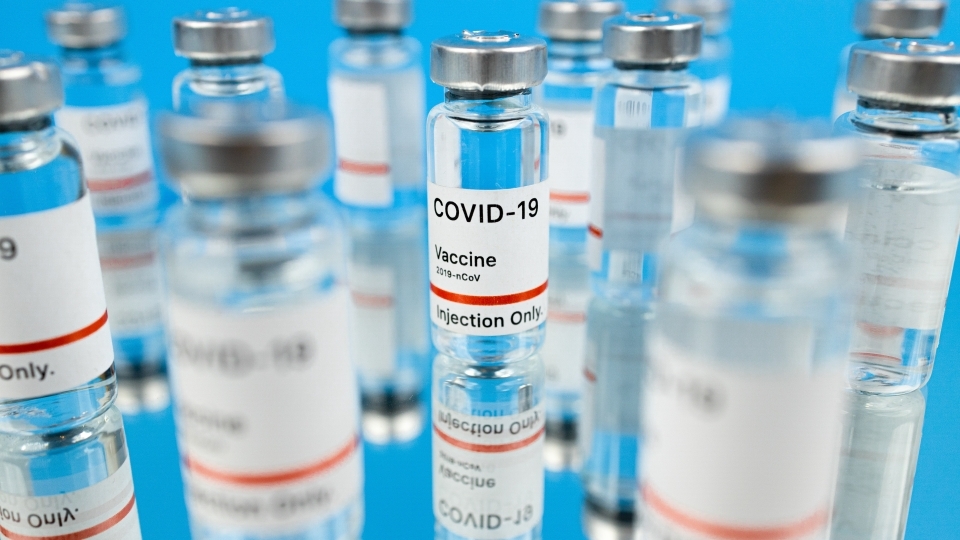A Primer on the COVID-19 Vaccines Available in the United States
January 27, 2021
- Author
- Jay Pfeifer

As COVID-19 cases in the United States surge, vaccine distribution is under way across the country.
More on COVID-19: Virus Variants
In a recent Forbes blog post, Wessner writes about the virus variants that have been making headlines around the world: A Virologist Explains What You Need to Know About the New Coronavirus Variants.
Dave Wessner, biology professor, studied the pathogenesis of coronaviruses as a post-doctoral researcher at the Uniformed Services University of the Health Sciences. He shares his insight on the COVID-19 vaccines in use today.
What distinguishes the two vaccines currently in circulation?
Broadly speaking, Moderna and Pfizer both use the same technique to encourage the body to produce antibodies that fight the virus that causes COVID-19. They both use a piece of messenger RNA that codes for the spike protein of the coronavirus.
What is a spike protein?
Think of the virus as a ball with lollipops sticking out—those lollipops are the spike proteins. These spike proteins allow the virus to attach to and ultimately infect our cells. And both vaccines have the mRNA of that protein encased in a nanoparticle.
The idea is, you get injected with that and the RNA gets into your cells. Your cells don't realize that this piece of mRNA is from the coronavirus, so they just begin producing the protein that it encodes—the coronavirus spike protein.
The Moderna and Pfizer vaccines are taking the genetic material for the spike protein and putting it in a lipid nanoparticle that gets injected. Your cells start producing the protein and the immune system says, “Wait a minute, that's not one of our proteins. That's something foreign.” And the cells produce antibodies, so if you get exposed to the real virus later the immune system is already up and running.
The other vaccines by AstraZeneca and Johnson & Johnson are very similar, but they have taken another virus called an adenovirus and they've clipped out part of the virus’s genome and replaced it with the spike protein gene from the coronavirus. That virus can replicate in the host, so your body starts to make those coronavirus spike proteins. And again, the immune system registers this and starts to mount a response.
Is this approach to vaccination new?
Both are new technologies. The adenovirus approach has been played with for quite a while, but this is the first time it’s come to fruition. The mRNA technique is really new. This is quite a departure from what we know as the standard technique.
The polio vaccine is a good example of the traditional approach. There are two different kinds of polio vaccine: an attenuated, or live, version, and the killed, or inactivated, version. Those two standard approaches have existed since the 1700s when the smallpox vaccine was developed. Both make use of the actual virus particle. The inactivated polio virus vaccine uses a virus that has been killed by formaldehyde. The live attenuated vaccine is a mutated version of the virus. It is close enough that your body develops the correct response, but it does not cause disease.
Just recently we've started thinking about using just bits and pieces of the virus rather than the whole thing.
Do we have a sense for how long the vaccines will be effective?
Not yet. That's one of the big problems with the flu vaccine—that’s why we get the flu vaccine every year. The flu virus mutates fairly rapidly, and the vaccine you get this year may not be a good match for what the flu looks like next year.
All the evidence out there so far—just nine months in—suggests that this coronavirus is not mutating particularly quickly. It seems to be fairly stable.
Vaccine researchers also don't know how long the human immune response will last. Some vaccines only require one dose and you're good to go for life. But others, like the tetanus vaccine, require boosters because your immune system sort of drops off over time. And there's really no way to know how long the immune response to the coronavirus vaccine will last until it’s been time-tested.
What was your reaction when you read that the vaccines were more than 90 percent effective?
Preliminary results suggest that the Moderna and Pfizer vaccine may be 95 percent effective. And AstraZeneca has reported that its vaccine may be 90 percent effective, although there are some concerns about their data. That's remarkable. Those are the numbers you see with the polio, measles and chickenpox vaccines, which are the real rock stars of the vaccine world. If those numbers hold up, I think that would be much better than anyone was expecting.
What kind of achievement would it be to produce a vaccine in less than a year?
It’s incredible. I study HIV, and our struggle to find a vaccine for HIV underscores how difficult it can be. HIV was discovered in 1983 and we still don't have a vaccine. Of course, they are two completely different beasts, but that gives you some context.
On one hand, we've got a 40-year project looking for a vaccine and there’s no end in sight for that one. On the other, we could have a vaccine rollout 18 months after the first case was reported. That is pretty remarkable.
Why is it so difficult to develop a vaccine for HIV?
There are a couple of reasons. First, HIV mutates really rapidly, including the main proteins that are on the surface that our immune system would recognize. And second, for reasons that aren't well understood, our immune system just doesn't make great antibodies to the HIV proteins.
If you get infected with coronavirus, it appears that your body makes really good antibodies that can bind to the virus and prevent it from infecting your cells. With HIV, your body's going to make all sorts of antibodies but, for whatever reason, they don't protect you from becoming infected.


